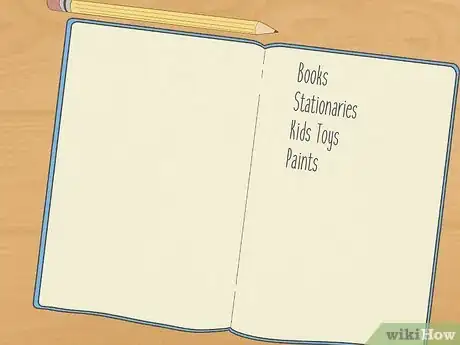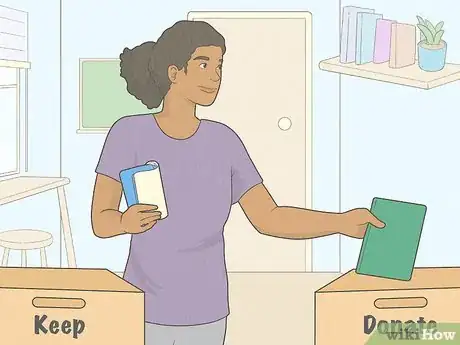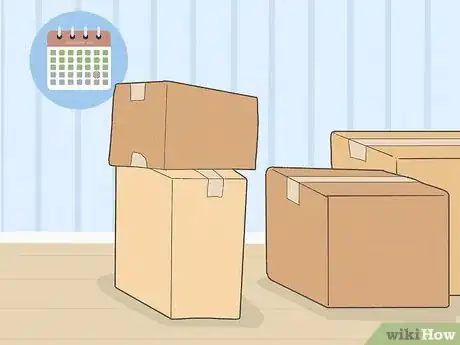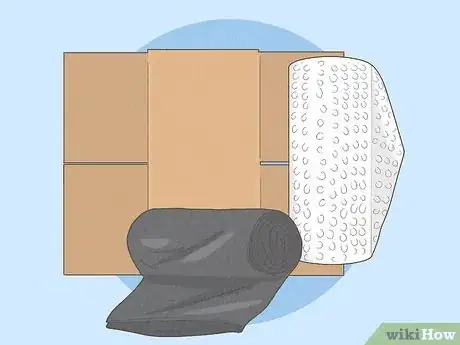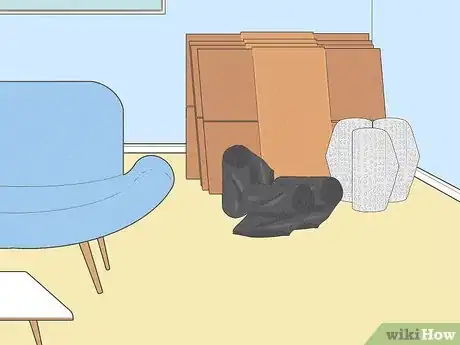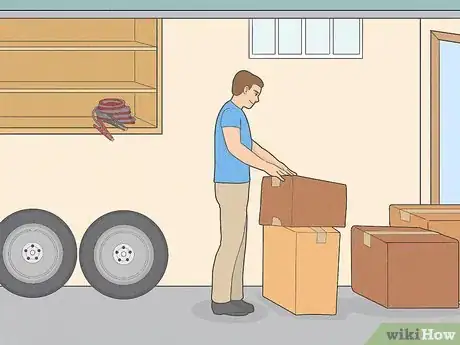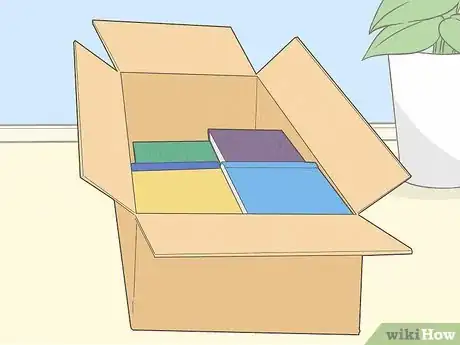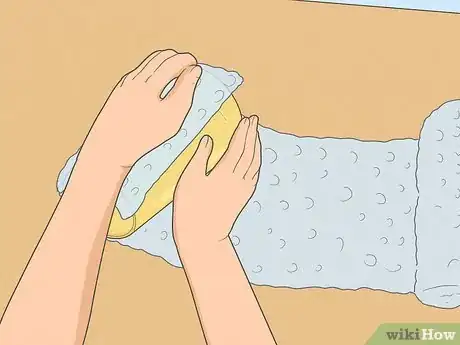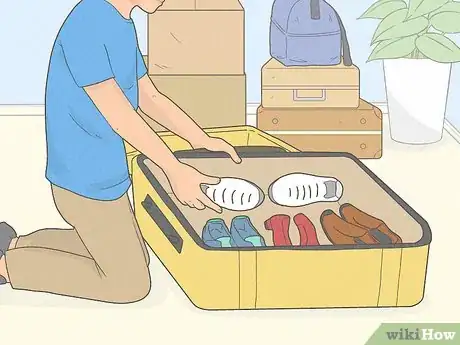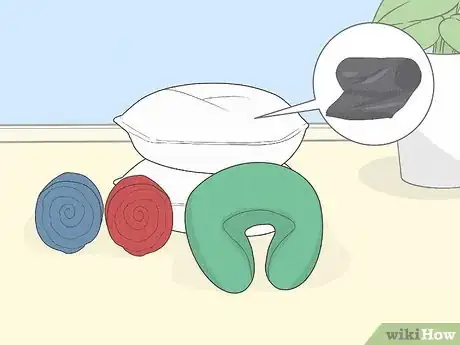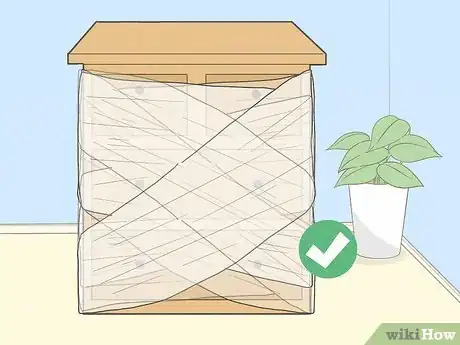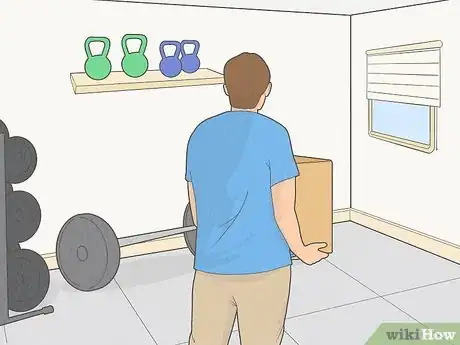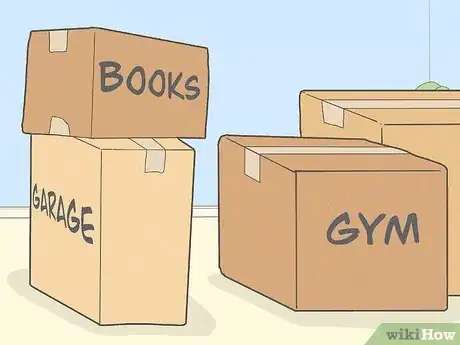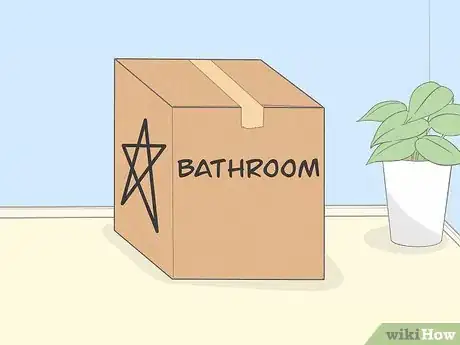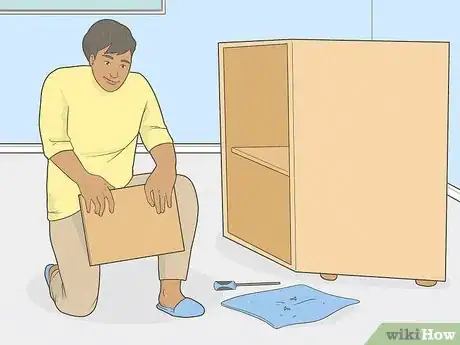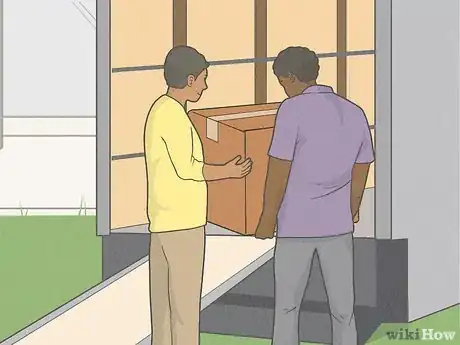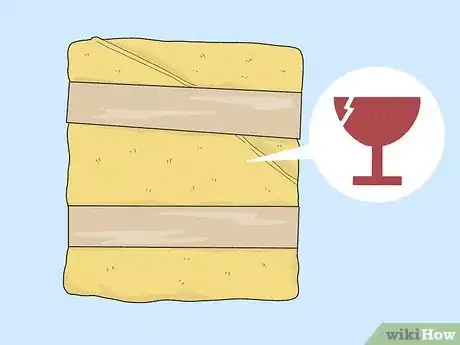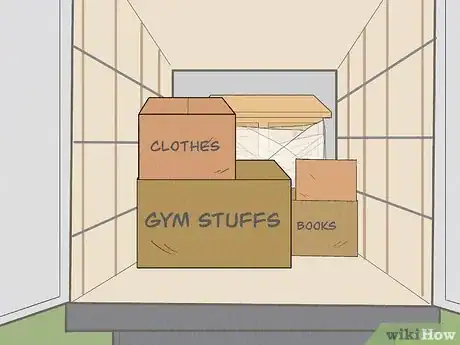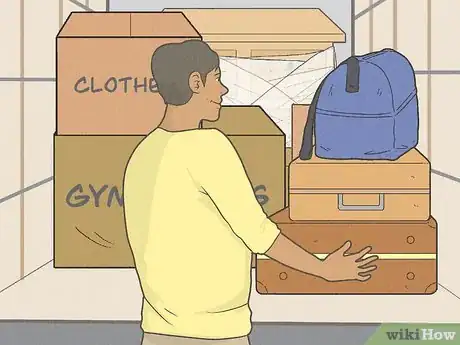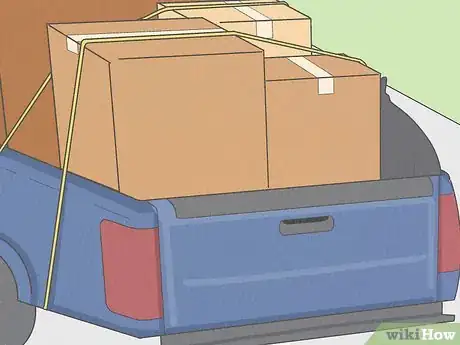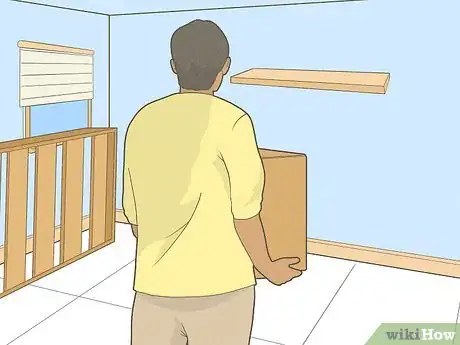This article was co-authored by Cindy Hofen. Cindy Hofen is a Certified Relocation Specialist and the founder of Managing Moves & More, a San Francisco Bay Area-based professional move management company specializing in start-to-finish moving solutions, home clearouts, estate sales, and home staging. Since 2009, her team has helped over 2,500 clients to simplify their transitions. Cindy has over 10 years of professional moving and organizing experience, is a member of the National Association of Senior Move Managers (NASMM), holds an A+ Accreditation, and belongs to the Diamond Society. She has a Master of Business Administration from Arizona State University and a BA in Business Economics from the University of California, Santa Barbara.
There are 13 references cited in this article, which can be found at the bottom of the page.
wikiHow marks an article as reader-approved once it receives enough positive feedback. In this case, 100% of readers who voted found the article helpful, earning it our reader-approved status.
This article has been viewed 174,982 times.
No matter how you slice it, moving is a big deal. It involves lots of work and, quite frankly, it can be a real pain. But, there are strategies you can use to take the hassle out of moving and make it as smooth as possible. Don’t wait until the last minute and start planning your move in advance by gathering supplies, keeping yourself organized, and using smart packing strategies.
Steps
Organizing the Move
-
1Mark an official moving date on your calendar. Set yourself a final moving date for when you need to load up the moving truck and make the trip to your new home. Use the official moving date to plan and organize your packing and supply gathering. Write the date in bold on a wall calendar or add it to your calendar app on your phone or email.[1]
- Avoid waiting until the last minute to start organizing your move. You can save yourself a lot of trouble and headaches by planning ahead!
-
2Call your utility companies and organize a service switch. Once you’ve got a moving date set, contact all of your utility companies including electricity, water, and internet. Let them know that you’re moving and schedule a service switch on your moving date. That way, everything will be up and running in your new home.[2]
- Make sure they’ll cut off service to your old home so you don’t keep paying for it.
- Many utility companies will allow you to switch over easily without any interruption in service.
- If you’re moving to an area with a different utility provider, research and choose a company, then contact them, and schedule to have your utilities set up.
Advertisement -
3Make a list of the items you need to move from your home. Take an inventory by walking through each room in your home and make a list of everything in it. Write down specific items such as furniture and decor, and lump general items together such as clothes and dishes.[3]
- You can also generalize items to make it easier to take an inventory. For instance, you could write “books” or “kid toys.”
- You may be surprised about how many things you have to move as well as how many items you don’t really need or use anymore.
-
4Use your list to get rid of unwanted or unnecessary items. Go through your inventory list and mark off items you want to give away, donate, or get rid of. Then, go through your home and declutter as many things as you can to help make your move easier.[4] [5]
- If there’s an item you have fond memories of but you’re not sure if you want to get rid of it, take a picture of it so you can remember it and pass it on to someone who can use it.
- The more items you can get rid of, the less you have to move!
-
5Hire a professional moving company for moving day if you can afford it. The easiest way to load up and move all of your items is to hire a moving company to do it. If you have the ability to hire a professional company, search online for one near you and contact them and schedule for them to assist you on your moving date.[6] [7]
- Depending on how far you have to move, a professional company can cost between $400-$1,210 to hire.
- Many moving companies also provide their own trucks and will unload your items at your new home.
-
6Rent a vehicle and ask for help on moving day if you plan to move by yourself. If you’re moving on your own, look up a moving truck rental company in your area and schedule a pickup for your moving date. Reach out to friends and family members and ask them if they can help you on the day of the move so they can plan on it.[8] [9]
- Moving is a lot of work and a big favor to ask, so you may want to get something like pizza and drinks for your moving buddies as a thank you.
-
7Try to start packing 2-3 weeks before moving day. You likely have more items to pack up then you realize, so avoid waiting until the last minute to start packing. A few weeks before your move, start the process of gathering and packing your belongings.[10]
- Set aside a few hours on the weekends or in the evenings to pack up some of your belongings.
-
8Get moving boxes, large trash bags, and bubble wrap. If you want new moving boxes, purchase them from a local box supply store. If you want to save on boxes, reach out to local grocery stores and moving companies, and ask if they have any you can take. Pick up some large trash bags for items like clothing and blankets. Get a roll bubble wrap to protect fragile items.[11]
- You can find bubble wrap at craft supply stores and packaging stores.
- You could also make a post on social media asking friends if they have any old moving boxes they don’t need.
-
9Set up a packing station to pack more efficiently. Gather your boxes, packing tape, bubble wrap, and trash bags and put them in a room or corner you don’t use as often in your home. Keep your packing materials and contained to 1 area so you’re able to pack up each room in your home more efficiently.[12]
- Keeping everything contained reduces the mess and clutter while you pack.
-
10Schedule a mail pickup to ship your books. If you have a lot of books, they can be heavy to pack up and take up space. Plus, if you use a moving company, they often charge by weight.[13] Visit the post office website to find shipping prices, pay for postage, and schedule a pickup.[14]
- Schedule the books to be delivered on the day you arrive at your new home.
- It’s much easier and often much cheaper to pay to have the books shipped by mail than by movers.
Packing for the Move
-
1Start by packing items you don’t use on a daily basis. Pack up the least used rooms in your home first, such as guest rooms or the garage, so you don’t need to pull items out once they’re packed. Work your way to more commonly used rooms like your living room and kitchen last.[15]
- You can also pack up items such as art, jewelry, and keepsakes first since you don’t use them as often.
-
2Fill boxes with similarly sized items based on where they belong. Go through a room and organize similarly sized items. Place them into boxes carefully and then seal the boxes shut with tape so when you open them, they’ll go to the same areas.[16]
- For example, keep books with books, wires with wires, and other similar items together.
- Avoid putting heavier items on top of lighter items.
-
3Wrap fragile items in bubble wrap before you pack them. Separate fragile or breakable items away from heavy, bulk items. Use bubble wrap to create a protective layer around the item. Secure the bubble wrap with packing tape so it doesn’t come off. Then, pack the item in a box with similarly sized items.[17]
- You can also use towels or clothes to wrap items such as dishes or glassware when you pack them into boxes.
-
4Place small, loose, or spillable items in plastic bags. Keep small items like wires, screws, and other electronics together by placing them inside of plastic bags so they don’t get lost. Pack up your toiletries in plastic bags as well so they’re easy to move and you’re able to unload them quickly at your new home.[18]
- Pack the bags of wires and electronics in a box with other items from the same room.
-
5Store your shoes in your suitcases to save on space. Your suitcases can serve as moving boxes since you have to bring them with you anyway! Fill them up with your shoes and other non-breakable items and close them up so you can load them on the truck.[19]
-
6Use trash bags for soft, non-breakable items. Fill the large trash bags with items such as clothes, towels, linens, and other soft items that can’t break or be damaged. Seal the bags shut by tying a knot when they’re full.[20]
- Trash bags are useful for soft items because they can squeeze into awkward spaces when you pack them into the moving truck.
- You can also put items like children’s toys or other sturdy, lightweight items in trash bags.
-
7Leave items in drawers to make them easier to move. Leave clothes in dressers so you can just load them up in the moving truck and unload them in your new home and they’ll be all set up. If you have desks with items in the drawers, leave them where they are so you don’t have to worry about packing them up.[21]
- If the drawers slide open easily wrap the outside of the desk or dresser in plastic wrap to keep them from opening.
-
8Finish packing 1 room completely before you move on to another. Focus on 1 room at a time and pack up all of the items. Leave the boxes in the room and move on to another. Work through the rooms in your home until everything is packed up and ready to go.[22]
-
9Label the boxes and seal them shut with packing tape. Use a marker to write what’s inside of a box once you finish packing it. Use brown packing tape to seal the box shut so it won’t open when you drive to your new home.[23]
- Write which room the box is for as well to make unloading easier.
- Labelling makes it much easier for you to move the boxes to the right rooms when you unload.
-
10Mark boxes with essential items that you’ll need to open first. Pack a box with items that you know you’ll need as soon as you get to your new home like toothbrushes, a change of clothes, or a phone charger. Make a special marking on it so you know to unload it first so you have everything you need.[24]
- It can take a few days to unpack all of your belongings at your new home, but it’s helpful to have your essential items when you arrive.
- Put a star or a special marking on the box so you can easily identify it.
Making the Move
-
1Disassemble your furniture before you load it into the moving truck. Use a screwdriver or Allen wrench to take apart furniture like beds and tables so they’re easier to load and take up less space in the truck. Start taking apart the items before you have the moving truck so they’re ready to be loaded when you have it.[25]
- Place the screws and pieces from the furniture in a plastic bag so you don’t lose them.
-
2Load the heaviest items into the moving truck first. Place the heaviest boxes and pieces of furniture first so the truck is balanced. Push them against the back wall without any space between them so they take up less room.[26]
- If you’re loading the truck yourself, have a friend help you lift heavier boxes and items.
-
3Wrap blankets and towels around the furniture to protect them. Use blankets and towels as padding between boxes and around furniture, lamps, and artwork so they’re protected. Tape the blankets and towels around the items so they don’t fall off in transit.[27]
- The layer of padding will help prevent scuffs and scrapes.
-
4Place longer items against the sides of the moving truck. Keep longer items such as mattresses, bed frames, and sofas against the sides of the wall of the truck so they’re out of the way and take up less space. Put them in the truck upright and lean them against the walls so they won’t fall over.[28]
- Try to keep a lane in the center of the truck open so you’re able to move more items toward the back.
-
5Stack lighter boxes on top of heavier ones in the truck. Balance the boxes by placing heavier ones on the bottom to create a strong base that will reduce movement while you’re driving. Then, stack lighter boxes on top so they aren’t crushed by heavier ones. Add all of the boxes into the truck.[29]
- Make sure the stacks are stable and won’t fall over while you’re driving.
-
6Add any remaining items into the truck after the boxes. Once everything is loaded up, you may be left with a few odd or lightweight items that you couldn’t back into boxes or are too fragile for boxes. Add them to the truck so they won’t be squished and you’ll be able to unload them easily.[30]
- You may want to place boxes with essential items toward the front as well so you can access them.
- If the items are fragile, make sure they’re wrapped well in bubble wrap.
-
7Tie ropes and straps to the side rails to secure the items. Once you’re all loaded up, connect string, rope, or straps to the side rails on the inside of the moving truck. Tighten them over the boxes and items and connect them to the rail on the opposite side of the truck to keep the items from shifting or falling over.[31]
- Tying down the boxes will help prevent them from falling over.
-
8Drive carefully to the destination. Brake sooner than you normally would when you’re driving your car to allow the truck to slow down more gently and prevent the items from shifting. Use your turn signals early and turn wider and more carefully to avoid accidents.[32]
- Follow the speed limit and look out for areas with lower speed limits for trucks as well.
- If you’re using a moving company, follow the moving truck on the way to your new home.
-
9Unload the boxes and items into their designated rooms. When you arrive at your new home, start unloading the truck but don’t worry about unpacking the boxes until everything is unloaded. Check the labels on the box and place them into the rooms they belong so you’ll be able to unpack them more easily.[33]
- For example, put the boxes with dishes in the kitchen and the ones with movies in the living room.
- Supervise the movers if you’re using a moving company so you can answer any questions they have while they’re unloading the truck.
Expert Q&A
-
QuestionHow do I choose a moving company?
 Cindy HofenCindy Hofen is a Certified Relocation Specialist and the founder of Managing Moves & More, a San Francisco Bay Area-based professional move management company specializing in start-to-finish moving solutions, home clearouts, estate sales, and home staging. Since 2009, her team has helped over 2,500 clients to simplify their transitions. Cindy has over 10 years of professional moving and organizing experience, is a member of the National Association of Senior Move Managers (NASMM), holds an A+ Accreditation, and belongs to the Diamond Society. She has a Master of Business Administration from Arizona State University and a BA in Business Economics from the University of California, Santa Barbara.
Cindy HofenCindy Hofen is a Certified Relocation Specialist and the founder of Managing Moves & More, a San Francisco Bay Area-based professional move management company specializing in start-to-finish moving solutions, home clearouts, estate sales, and home staging. Since 2009, her team has helped over 2,500 clients to simplify their transitions. Cindy has over 10 years of professional moving and organizing experience, is a member of the National Association of Senior Move Managers (NASMM), holds an A+ Accreditation, and belongs to the Diamond Society. She has a Master of Business Administration from Arizona State University and a BA in Business Economics from the University of California, Santa Barbara.
Professional Organizer & Home Staging Specialist I would suggest looking online, looking at reviews, and getting 2-3 quotes. Compare them and make sure you understand insurance. Make sure you understand pickup and delivery. Are they going to deliver inside or outside? Having 2-3 different estimates is really going to give you a lot of information and help you choose the one that seems to be the best fit.
I would suggest looking online, looking at reviews, and getting 2-3 quotes. Compare them and make sure you understand insurance. Make sure you understand pickup and delivery. Are they going to deliver inside or outside? Having 2-3 different estimates is really going to give you a lot of information and help you choose the one that seems to be the best fit. -
QuestionHow much does it typically cost to hire a moving company?
 Cindy HofenCindy Hofen is a Certified Relocation Specialist and the founder of Managing Moves & More, a San Francisco Bay Area-based professional move management company specializing in start-to-finish moving solutions, home clearouts, estate sales, and home staging. Since 2009, her team has helped over 2,500 clients to simplify their transitions. Cindy has over 10 years of professional moving and organizing experience, is a member of the National Association of Senior Move Managers (NASMM), holds an A+ Accreditation, and belongs to the Diamond Society. She has a Master of Business Administration from Arizona State University and a BA in Business Economics from the University of California, Santa Barbara.
Cindy HofenCindy Hofen is a Certified Relocation Specialist and the founder of Managing Moves & More, a San Francisco Bay Area-based professional move management company specializing in start-to-finish moving solutions, home clearouts, estate sales, and home staging. Since 2009, her team has helped over 2,500 clients to simplify their transitions. Cindy has over 10 years of professional moving and organizing experience, is a member of the National Association of Senior Move Managers (NASMM), holds an A+ Accreditation, and belongs to the Diamond Society. She has a Master of Business Administration from Arizona State University and a BA in Business Economics from the University of California, Santa Barbara.
Professional Organizer & Home Staging Specialist It depends a lot on the services you want. On the higher end of the spectrum, you can pay for a company to come and do all of the packing, moving, and unpacking for you. On the other end of the spectrum the moving company would take everything to your new house but you'd be responsible for packing and unpacking everything. The other variable is how much stuff you have. The more you have to move, the more expensive it will be.
It depends a lot on the services you want. On the higher end of the spectrum, you can pay for a company to come and do all of the packing, moving, and unpacking for you. On the other end of the spectrum the moving company would take everything to your new house but you'd be responsible for packing and unpacking everything. The other variable is how much stuff you have. The more you have to move, the more expensive it will be.
References
- ↑ https://www.washingtonpost.com/lifestyle/home/an-organizers-tips-for-a-smooth-move/2015/06/16/c81c6428-0f89-11e5-9726-49d6fa26a8c6_story.html
- ↑ https://www.goodhousekeeping.com/home/organizing/tips/a24991/moving-house-checklist/
- ↑ https://www.washingtonpost.com/lifestyle/home/an-organizers-tips-for-a-smooth-move/2015/06/16/c81c6428-0f89-11e5-9726-49d6fa26a8c6_story.html
- ↑ https://www.consumeraffairs.com/movers/how-to-pack-for-move.html
- ↑ Cindy Hofen. Professional Organizer & Home Staging Specialist. Expert Interview. 13 February 2020.
- ↑ https://www.realsimple.com/home-organizing/organizing/moving/plan-relatively-stressless-house-move
- ↑ Cindy Hofen. Professional Organizer & Home Staging Specialist. Expert Interview. 13 February 2020.
- ↑ https://www.realsimple.com/home-organizing/organizing/moving/plan-relatively-stressless-house-move
- ↑ Cindy Hofen. Professional Organizer & Home Staging Specialist. Expert Interview. 13 February 2020.
- ↑ https://www.denverpost.com/2013/08/30/home-design-pack-fast-move-fast-with-these-12-tips/
- ↑ https://www.denverpost.com/2013/08/30/home-design-pack-fast-move-fast-with-these-12-tips/
- ↑ https://www.denverpost.com/2013/08/30/home-design-pack-fast-move-fast-with-these-12-tips/
- ↑ Cindy Hofen. Professional Organizer & Home Staging Specialist. Expert Interview. 13 February 2020.
- ↑ https://www.consumeraffairs.com/movers/how-to-pack-for-move.html
- ↑ https://www.consumeraffairs.com/movers/how-to-pack-for-move.html
- ↑ https://www.washingtonpost.com/lifestyle/home/an-organizers-tips-for-a-smooth-move/2015/06/16/c81c6428-0f89-11e5-9726-49d6fa26a8c6_story.html
- ↑ https://www.denverpost.com/2013/08/30/home-design-pack-fast-move-fast-with-these-12-tips/
- ↑ https://www.consumeraffairs.com/movers/how-to-pack-for-move.html
- ↑ https://youtu.be/E59F0L8we6A?t=438
- ↑ https://www.denverpost.com/2013/08/30/home-design-pack-fast-move-fast-with-these-12-tips/
- ↑ https://www.consumeraffairs.com/movers/how-to-pack-for-move.html
- ↑ https://www.consumeraffairs.com/movers/how-to-pack-for-move.html
- ↑ https://www.realsimple.com/home-organizing/organizing/moving/plan-relatively-stressless-house-move
- ↑ https://www.consumeraffairs.com/movers/how-to-pack-for-move.html
- ↑ https://www.housebeautiful.com/uk/renovate/a1531/real-truth-about-moving-house/
- ↑ https://youtu.be/IDElnG7lv8Q?t=62
- ↑ https://www.denverpost.com/2013/08/30/home-design-pack-fast-move-fast-with-these-12-tips/
- ↑ https://www.syracuse.com/immoving/2016/07/how_to_load_a_moving_truck_pro.html
- ↑ https://youtu.be/IDElnG7lv8Q?t=109
- ↑ https://www.vogue.com/article/how-to-move-stress-free-tips-secrets
- ↑ https://www.syracuse.com/immoving/2016/07/how_to_load_a_moving_truck_pro.html
- ↑ https://youtu.be/8deNqnjhHqs?t=71
- ↑ https://www.consumeraffairs.com/movers/how-to-pack-for-move.html


